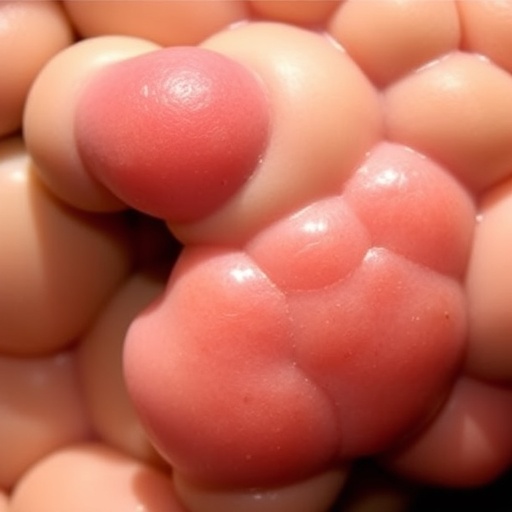In a groundbreaking publication that promises to reshape our understanding of liver fibrosis, researchers have uncovered the pivotal role of the kinase NEK7 in maintaining the delicate equilibrium of mitochondrial respiratory chain electron transport through its interaction with the succinate dehydrogenase complex subunit B (SDHB). This discovery opens new avenues for therapeutic strategies aimed at combatting chronic liver diseases, which remain a significant global health burden. The study, recently published in Nature Communications, reveals the molecular intricacies behind how NEK7 couples with SDHB to orchestrate electron transport homeostasis, thereby impeding the pathological progression of liver fibrosis.
Liver fibrosis, characterized by excessive scar tissue formation resulting from chronic liver injury, often precedes cirrhosis and liver failure, conditions with few effective treatments. Central to the progression of fibrosis is mitochondrial dysfunction, especially disruptions in the electron transport chain (ETC), which impacts cellular energy production and oxidative stress dynamics. Sun et al. have delved into the molecular choreography that sustains mitochondrial integrity amid fibrogenic stimuli, identifying NEK7 as a key regulatory node. Their research sheds light on a sophisticated control mechanism where NEK7 physically and functionally couples to SDHB, a catalytic subunit of Complex II in the ETC, to preserve electron flux and reduce mitochondrial reactive oxygen species (ROS) accumulation.
At the heart of this research is the assessment of how NEK7 influences the respiratory chain’s efficiency. Complex II, or succinate dehydrogenase, serves a dual function in the tricarboxylic acid (TCA) cycle and the ETC, making its regulation crucial for cellular metabolism. By interacting with SDHB, NEK7 stabilizes Complex II function, ensuring that electrons are effectively transported without premature leakage that triggers oxidative damage. This nuanced regulation helps maintain ATP synthesis and controls the redox environment within hepatic cells, a critical factor in preventing the activation of fibrotic pathways.
The investigative team employed an array of biochemical and cell biology techniques to delineate the interaction between NEK7 and SDHB. Co-immunoprecipitation and proximity ligation assays confirmed the physical coupling of these proteins in mitochondria isolated from hepatic tissues. Functional assays incorporating respiratory flux measurements and mitochondrial membrane potential assessments demonstrated that the presence of NEK7 preserves mitochondrial efficiency and prevents electron transport derailment under stress conditions. These findings underscore the protective role of NEK7 in maintaining mitochondrial homeostasis, essential for healthy liver function.
Intriguingly, loss-of-function experiments in which NEK7 expression was suppressed revealed exacerbated mitochondrial dysfunction. Knockdown models showcased diminished Complex II activity, heightened ROS production, and a marked increase in markers of fibrogenesis. This phenotype correlated with amplified activation of hepatic stellate cells (HSCs), the principal effectors of fibrotic scarring. Conversely, overexpressing NEK7 ameliorated mitochondrial impairment and restrained fibrotic cascades, highlighting the therapeutic potential of targeting NEK7 pathways.
Further mechanistic insights uncovered by the study include how NEK7 modulates the conformation of SDHB, thereby optimizing its electron transfer capabilities. Structural analyses suggest NEK7-mediated phosphorylation events may induce allosteric modifications in SDHB, enhancing its affinity for electron donors and acceptors within Complex II. Such molecular fine-tuning represents a sophisticated example of post-translational regulation in mitochondrial bioenergetics, which could be exploited for drug development.
Given the centrality of mitochondrial dysfunction in a wide range of chronic diseases, these findings hold implications that extend beyond liver pathology. By establishing NEK7 as a mitochondrial quality control factor, the study bridges the fields of cellular signaling and metabolism, providing a conceptual framework for investigating kinase-mediated regulation of energy homeostasis in other organs susceptible to fibrosis, including the heart, kidney, and lung.
Moreover, this research propels NEK7 into the spotlight as a promising biomarker and therapeutic target. The ability of NEK7 to counterbalance oxidative stress and maintain ETC function positions it as a molecular switch that could be modulated pharmacologically to halt or reverse fibrotic progression. Small molecules or gene therapy approaches aimed at enhancing NEK7 activity might thus represent innovative treatments for liver fibrosis and potentially other fibrotic disorders.
The study’s findings were corroborated in vivo using mouse models of liver fibrosis induced by chronic injury. Mice deficient in NEK7 exhibited severe impairment in respiratory chain function, increased fibrotic deposition, and worsened liver histopathology compared to controls. Treatment with agents that restored NEK7 activity ameliorated these pathological changes, affirming the kinase’s critical role in vivo and reinforcing its therapeutic relevance.
Additionally, the authors explored the link between NEK7-SDHB interaction and inflammatory signaling pathways. They reported that preserving respiratory chain integrity via NEK7 prevents activation of inflammasomes, multiprotein complexes implicated in sterile inflammation and fibrosis. This cross-talk between mitochondrial homeostasis and immune responses adds an extra layer of complexity to the fibrotic process and highlights the multifaceted functions of NEK7.
In the context of liver disease, where oxidative damage and chronic inflammation synergize to drive fibrosis, the protective role of NEK7 may represent a key defensive mechanism evolved to mitigate cellular stress. These findings invite future investigation into the modulation of NEK7 by metabolic and environmental factors, potentially linking lifestyle and dietary influences to mitochondrial resilience and liver health.
While the study presents compelling evidence delineating NEK7’s role, several questions remain open. It will be essential to determine the upstream signals that regulate NEK7 expression and activity within hepatic cells under fibrotic stimuli. Furthermore, understanding the tissue-specific nuances of NEK7 function and its broader interactome within the mitochondrial milieu could reveal additional targets for comprehensive intervention strategies.
As a broader perspective, the identification of NEK7 as a kinase intricately involved in mitochondrial electron transport challenges the traditional view of kinases as predominantly cytoplasmic or nuclear regulators. This research exemplifies the emerging appreciation of mitochondrial kinases as critical modulators of organelle function, paving the way for a new frontier in mitochondrial biology focused on enzymatic regulation of metabolic complexes.
Sun et al.’s pioneering work offers a vivid example of translational research, integrating molecular biology, structural biochemistry, and pathophysiology to tackle a daunting clinical challenge. By illuminating the intricate molecular interplay between NEK7 and SDHB, their study furnishes a detailed map of respiratory chain regulation that could inform drug discovery and personalized medicine approaches for liver fibrosis.
In conclusion, the insights uncovered establish a paradigm wherein NEK7 serves as a molecular gatekeeper, adeptly maintaining respiratory chain electron transport homeostasis to forestall liver fibrosis. This discovery not only enhances our fundamental understanding of mitochondrial biology in hepatic pathophysiology but also propels NEK7 to the forefront of emerging antifibrotic therapies. As liver fibrosis continues to pose a major health threat worldwide, innovations borne from such molecular elucidations offer hope for effective intervention and improved patient outcomes.
Subject of Research: Molecular mechanisms underlying mitochondrial respiratory chain regulation and its role in liver fibrosis.
Article Title: NEK7 couples SDHB to orchestrate respiratory chain electron transport homeostasis that impedes liver fibrosis.
Article References:
Sun, Z., Sun, L., Hua, H. et al. NEK7 couples SDHB to orchestrate respiratory chain electron transport homeostasis that impedes liver fibrosis. Nat Commun 16, 10751 (2025). https://doi.org/10.1038/s41467-025-65790-0
Image Credits: AI Generated
DOI: https://doi.org/10.1038/s41467-025-65790-0
Tags: chronic liver injury and fibrosiselectron transport chain regulationliver disease research advancementsmitochondrial dysfunction in liver diseasemitochondrial integrity in fibrosismolecular mechanisms of liver fibrosisNEK7 and liver fibrosisNEK7 as a therapeutic targetoxidative stress and liver healthrole of kines in metabolismSDHB interaction in mitochondriatherapeutic strategies for chronic liver diseases





